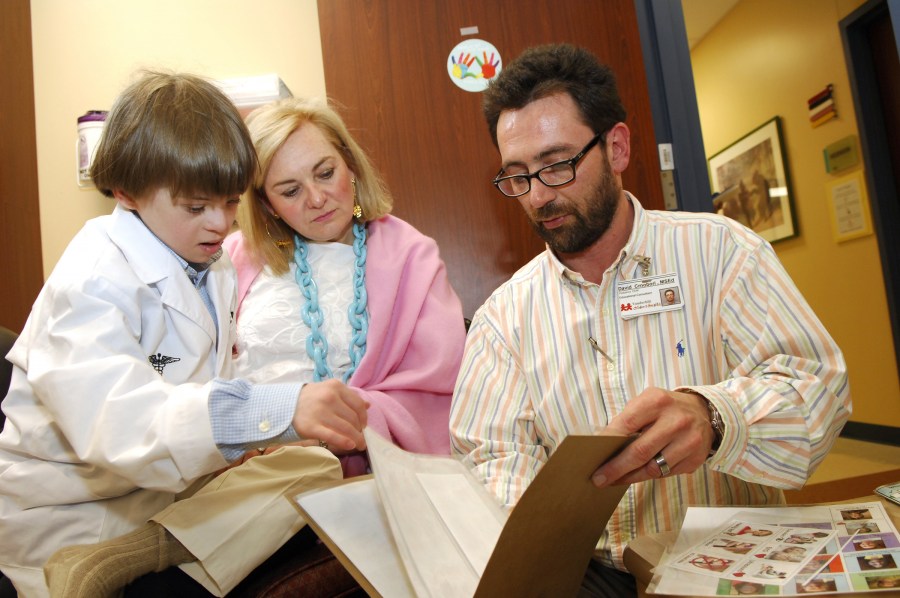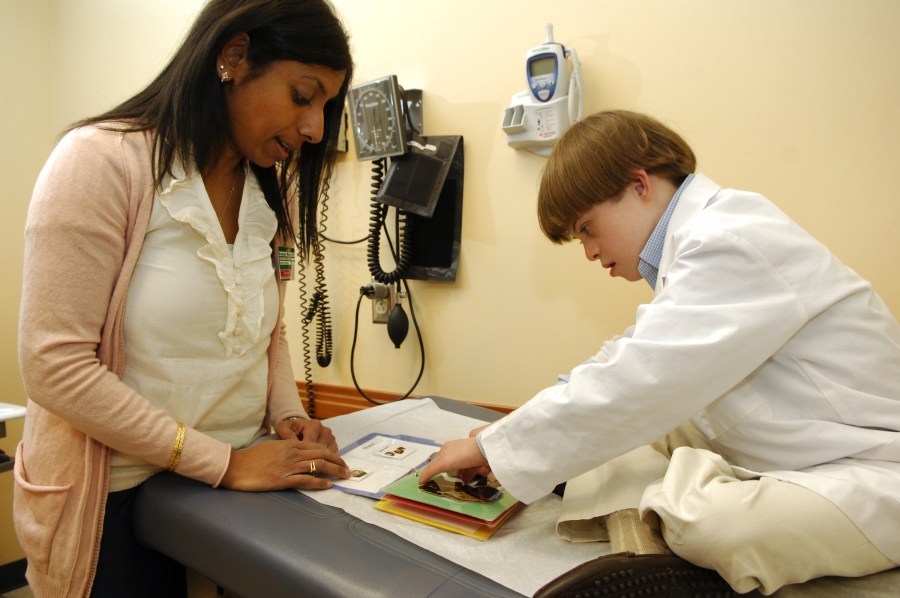
David Crnobori, M.S., E.D., right, shows Michael Blackburn and his mother, Bunny, picture books that help explain what will take place during Michael’s clinic visit. (photo by Anne Rayner)
Communication tools ease children’s clinic visit fears
Eleven-year-old Michael Blackburn confidently informs Niru Madduri, M.D., that she needs to listen to his heart with her stethoscope.
He knows that’s part of the routine during his visit to the Down Syndrome Clinic at the Center for Child Development in the Monroe Carell Jr. Children's Hospital at Vanderbilt. A visual photo schedule, part of every child’s visit, lets him know what to expect next, reducing any anxiety he has about a clinical exam.
For every patient’s visit, the Center for Child Development has implemented the use of communications tools — such as pictures or words – that provide structure and facilitate language for children who have development disabilities.
The center primarily sees children ages 18 months to 14 years for concerns of development delay.
“From the time they get here to the time they leave there is information that they can see, and that helps ease anxiety and makes for better exams, smoother visits,” said David Crnobori, M.S.Ed., behavior consultant at the Center.
“As their anxiety goes up their ability to hear what you’re saying goes down. So words become less effective. These are supports.”
The pictures show patients, such as Michael, a short narrative about what happens each moment at the clinic. He checks in; he sits in the waiting room; a nurses calls his name; he has a blood pressure check and weight taken; and so on. Each step is depicted in a picture on a small panel.
“We love the visual schedule,” said Michael’s mother, Bunny Blackburn. “It makes the visit predictable for Michael. He is always concerned about what’s next. It’s easy for him to keep up with it. It decreases the stress of what we’re about to do. He knows what we’re going to do before we do it.”

Niru Madduri, M.D., and 11-year-old Michael Blackburn demonstrate the communication tools used to reduce anxiety about clinic visits. (photo by Anne Rayner)
Visuals supports have been commonplace in education for years. But the supports have been slower to enter clinical settings. They are routinely used at the Vanderbilt Kennedy Center, and now the Center for Child Development. Other pediatric clinics are also interested.
“Previously, a checkup was verbally explained,” said Crnobori. “A lot of kids didn’t understand and there were a lot of tantrums. When parents come in here, they’ll say, ‘this is the first time we’ve gotten blood pressure.’ The child’s anxiety is often so high that any request is met with resistance. By having a different way of seeing it and a procedure to follow — it has really helped a lot of kids.”
Madduri, clinical director for the Center for Child Development, said the storyboards make exams more efficient. Before, children would not get through exams because they couldn’t understand the process.
She uses a two-tier storyboard, so when the child finishes a task they can move the Velcro-attached picture from the top row to the bottom row.
“They understand they get a reward for being a part of the process, and the kids get some sense of control,” Madduri said.
Michael enjoys the storyboard, including when he gets to pick a prize out of the treasure chest, the second-to-last task in his story before leaving. He chooses a ball that sticks to the wall.
“We love to come to Children’s Hospital,” Bunny Blackburn said. “Michael calls it his hospital. He’s here about three days a week some weeks. Everything with Vanderbilt, he says, ‘that’s my hospital.’”
“I love it,” Michael said, also telling Madduri about the clinic, “You have a lovely home.” q













